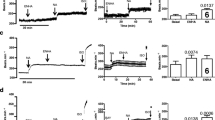Summary
The effects of some phosphodiesterase (PDE) inhibitors (dipyridamole, theophylline, papaverine and SH-869) on prostacyclin (PGI2) production have been studied in vitro and in vivo. PGI2 was bioassayed by Vane's superfusion technique. In rabbit aortic rings, only dipyridamole in concentrations from 1 to 12 µM was able to stimulate PGI2 biosynthesis in a dose-dependent manner. This effect was also detected with so-called “exhausted” rabbit aortic rings. The other PDE inhibitors used, both in µM and mM concentration, did not affect PGI2 biosynthesis. Dipyridamole was found to increase PGI2 production in healthy volunteers, when given both by infusion (8 µg/kg/min × 2 h) and by oral administration (375 mg/day for seven days). Circulating PGI2 and PGI2 production induced by a 3-min period of ischaemia were increased by an average of 137% (p<0.001) and 30.8% (p<0.001) respectively. Saline and theophylline (as aminophylline) infusions used as controls did not affect PGI2 production.
Similar content being viewed by others
References
Mills DC, Smith JP (1971) The influence on platelet aggregation of drugs that affect the accumulation of adenosine 3′ 5′ cyclic monophosphate in platelets. J Biochem 121: 185–196
Rozenberg MC, Walker CM (1973) The effect of pyrimidine compounds on the potentiation of adenosine inhibition of aggregation, on adenosine phosphorylation and phosphodiesterase activity of blood platelets. Br J Haematol 24: 409–418
McElroy FA, Philip RB (1975) Relative potencies of dipyridamole and related agents as inhibitors of cyclic nucleotide phosphodiesterases: possible explanation of mechanism of inhibition of platelet function. Life Sci 17: 1479–1493
Castaldi PA (1975) Prophylactic agents for thrombosis. Drugs 9: 1–3
Moncada S, Korbut R (1978) Dipyridamole and other phosphodiesterase inhibitors act as antithrombotic agents by potentiating endogenous prostacyclin. Lancet 1: 1286–1289
Horrobin DF, Ally AI, Manku MS (1978) Dipyridamole and platelet aggregation. Lancet 2: 270
Oliw E, Anggard E, Fredholm BB (1977) Effect of indomethacin on the renal actions of theophylline. Eur J Pharmacol 43: 9–16
Ahnfelt-Rønne I (1978) In vitro stimulation of prostaglandin synthetase by methyl xanthines. Prostaglandins 16: 711–724
Vane JR (1969) The release and fate of vaso-active hormones in the circulation. Br J Pharmacol 35: 209–242
Ferreira SH, De Souza Costa F (1976) A laminar flow superfusion technique with much increased sensitivity for the detection of smooth muscle-stimulating substances. Eur J Pharmacol 39: 379–381
Neri Serneri GG, Masotti G, Poggesi L, Galanti G (1980) Release of prostacyclin into the bloodstream and its exhaustion in humans after local blood flow changes (ischemia and venous stasis). Thromb Res 17: 197–208
Moncada S, Needleman P, Bunting S (1976) Prostaglandin endoperoxide and thromboxane generating system and their selective inhibition. Prostaglandins 12: 323–335
Omini C, Moncada S, Vane JR (1977) The effects of prostacyclin (PGI2) on tissues which detect prostaglandins (PG's). Prostaglandins 14: 625–633
Rajah SM, Crow MJ, Penny AF, Ahmad R, Watson DA (1977) The effect of dipyridamole on platelet function: correlation with blood levels in man. Br J Clin Pharmacol 41: 129–133
Francini D, Abbate R (1979) Azione antiaggregante del dipiridamolo somministrato per infusione endovenosa lenta. Clin Terap 52: 1–13
Kadatz R, Schröter HW, Weisenberger H (1975) Pharmacotherapie des affections cardiaques ischemiques. La Persantine — Presentation de l'action pharmacologique, biochimique et clinique. Ars Medici 30: 753–770
Jusko WJ, Koup JR, Vance WJ, Schentag JJ, Kuritzky P (1977) Intravenous theophylline therapy: nomogram guidelines. Ann Intern Med 35: 400–404
Miller RB, Leslie ST, Black FM, Boroda C (1978) A controlled release papaverine tablet (Papacontin): a study in normal volunteers. Br J Clin Pharmacol 5: 51–54
Bunting S, Moncada S, Reed P, Salmon JA, Vane JR (1978) An antiserum to 5,6-dihydro prostacyclin (PGI1) which also binds prostacyclin. Prostaglandins 15: 565–573
Mitchell MD (1978) A sensitive radioimmunoassay for 6-keto-prostaglandin F1 alpha: preliminary observations on circulating concentrations. Prostaglandins Med. 1: 13–21
Dollery CT, Friedman LA, Hensby CN, Kohner E, Lewis PJ, Portal M, Webster J (1979) Circulating prostacyclin may be reduced in diabetes. Lancet 2: 1365
Mullane KM, Dustin GJ, Salmon JA, Moncada S, Vane JR (1979) Biotransformation and cardiovascular effects of arachidonic acid in the dog. Eur J Pharmacol 54: 217–228
Wong PYK, Malik KU, Desiderio DM, McGiff JC, Sun FF (1980) Hepatic metabolism of prostacyclin (PGI2) in the rabbit: formation of a potent novel inhibitor of platelet aggregation. Biochem Biophys Res Commun 93: 486–494
Masotti G, Poggesi L, Galanti G, Neri Serneri GG (1979) Stimulation of prostacyclin by dipyridamole. Lancet 1: 1412
Masotti G, Poggesi L, Galanti G, Neri Serneri GG (1979) Increase of circulating PGI2 and PGI2 released by vessel wall after dipyridamole. Thromb Haemost 42: 197
Neri Serneri GG, Masotti G, Abxate R, Poggesi L, Gensini GF, Favilla S, Galanti G, Laureano R (1979) Enhanced prostacyclin production and decreased thromboxane formation by dipyridamole. In: Mason DT, Neri Serneri GG, Oliver MF (eds) Myocardial infarction. Excerpta Medica, Amsterdam, pp 489–494
Dusting G, Moncada S, Vane JR (1977) Prostacyclin (PGX) is the endogenous metabolite responsible for relaxation of coronary arteries induced by arachidonic acid. Prostaglandins 13: 3–15
Blass KE, Block HU, Förster W, Pönicke K (1980) Dipyridamole: a potent stimulator of prostacyclin (PGI2) biosynthesis. Br J Pharmacol 68: 71–73
Author information
Authors and Affiliations
Rights and permissions
About this article
Cite this article
Neri Serneri, G.G., Masotti, G., Poggesi, L. et al. Enhanced prostacyclin production by dipyridamole in man. Eur J Clin Pharmacol 21, 9–15 (1981). https://doi.org/10.1007/BF00609581
Received:
Revised:
Accepted:
Issue Date:
DOI: https://doi.org/10.1007/BF00609581




